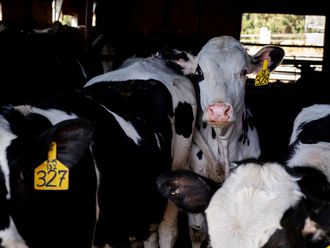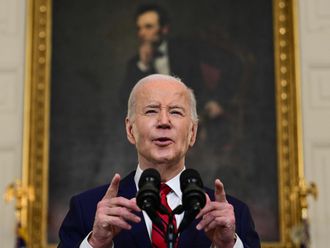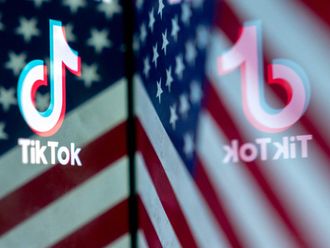
New Orleans: Heavy rains and gusty winds knocked out power on the Gulf Coast as a strengthening Tropical Storm Barry churned a path to shore, threatening millions and testing flood-prevention efforts implemented after Hurricane Katrina devastated New Orleans 14 years ago.
Officials predicted Barry would make landfall as this year’s first hurricane Saturday morning near Morgan City, west of New Orleans, where a curfew has been set until 6am and a long day started with on and off rain, power outages and people using cell phones to see in the dark and opening doors and windows to let the warm, sticky tropical air circulate.
As dawn approached Saturday, more than 45,000 people in southern Louisiana had lost power. The edges of the storm lashed Louisiana and coastal Mississippi and Alabama with rain, leaving some roads underwater overnight.
Though expected to be a weak hurricane — just barely over the 119km/h wind speed threshold — it threatened disastrous flooding across a swath of the Gulf Coast. The storm was expected to inflict the most damage on Louisiana and parts of Mississippi, with wind and rain affecting more than 3 million people.
Late Friday night, residents received good news from forecasters: The Mississippi River is expected to crest in New Orleans at about 5.2 metres on Monday, not 5.8 metres as had been earlier predicted. The levees protecting the city range from about 6 to 7.5 metres in height.
On-again, off again rain hit New Orleans overnight. As day broke, the streets in the normally raucous French Quarter tourist district were largely empty but barely damp. One woman walked her dog, and a street sweeper rambled by. It was breezy, but flags on balconies overhanging the empty streets still occasionally fell limp. A few cars were out on roads. Some nearby homes had piled sandbags outside their doors.
Baton Rouge, which was devastated by floods in 2016, was similarly quiet Saturday, with puddles left from overnight rains, wind shaking the trees and only a few cars and trucks on thoroughfare Interstate 10. In Alabama, rain pounded the eastern shore of Mobile Bay overnight, with scattered power outages in communities including Daphne, along Interstate 10.
Forecasters warned that most of the storm’s rain remained over the Gulf of Mexico and would likely move into Louisiana and Mississippi later Saturday. There were predictions of 25 to 50 centimetres of rain through Sunday across a swath of Louisiana that includes New Orleans and Baton Rouge with some parts of the state possible getting 63 centimetres.
“It’s powerful. It’s strengthening. And water is going to be a big issue,” National Hurricane Centre Director Ken Graham warned.
Governors declared emergencies in Louisiana and Mississippi, and authorities took unprecedented precautions in closing floodgates and raising the barriers around New Orleans.
Gov. John Bel Edwards said it was the first time all floodgates were sealed in the New Orleans-area Hurricane Risk Reduction System since Katrina. Still, he said he didn’t expect the Mississippi River to spill over the levees despite water levels already running high from spring rains and melting snow upstream.
“My concerns are just hoping it’s not going to be another Katrina,” said Donald Wells, a restaurant cook in New Orleans.
Authorities told at least 10,000 people in exposed, low-lying areas along the Gulf Coast to leave, but no evacuations were ordered in New Orleans, where officials urged residents to “shelter in place.”
Before they did, people packed stores to stock up on bottled water, food and other essentials.
Lifelong New Orleans resident Terrence Watkins grabbed supplies at a Costco, saying he has a few simple rules for big storms.
“Stock up on water. Stock up food. Get ready for the storm — ride it out,” he said.
Workers shored up and raised the levee system in places with beams, sheet metal and other barriers.
Rescue crews and about 3,000 National Guard troops were posted around Louisiana with boats, high-water vehicles and helicopters. President Donald Trump declared a federal emergency for Louisiana, authorising federal agencies to coordinate relief efforts.
The impending storm also triggered a legal spat between neighbouring parishes. East Baton Rouge Parish won a temporary restraining order against the AquaDams that Iberville Parish planned to deploy along Bayou Manchac. A federal judge ruled Friday night that the water-filled flood control barriers could cause substantial property damage and loss of life in East Baton Rouge.
Scientists say global warming is responsible for more intense and more frequent storms and flooding, but without extensive study, they cannot directly link a single weather event to the changing climate.
Tracking forecasts showed the storm moving toward Chicago, swelling the Mississippi River basin with water that must eventually flow south again.
Before the worst of the storm, Kaci Douglas and her 15-year-old son, Juan Causey, were among dozens filling sandbags at a fire station in Baton Rouge. She planned to use them to shore up the door of her town house.
“I told my son, it’s better to be safe than sorry,” she said.
In New Orleans, a group of neighbours cleaned out the storm drains on their street. Working together to lift off the heavy metal covers, they discovered that most of the drains were full of dirt, leaves and garbage.
All over town, people parked their cars on the city’s medians — referred to by locals as “neutral grounds” — in hopes their vehicles would be safe on the slightly elevated strips.
After Katrina was blamed for more than 1,800 deaths, by some estimates, the Army Corps of Engineers began a multibillion-dollar hurricane-protection system that isn’t complete. The work included repairs and improvements to some 560 kilometres of levees and more than 70 pumping stations.












